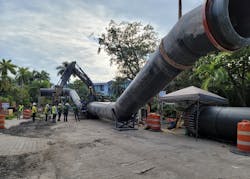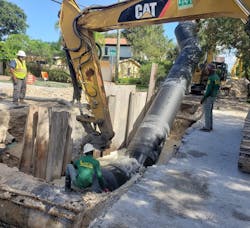About the author:
Steve Cooper is director/writer for SCA Communications. Cooper can be reached at [email protected].
Reminiscent of linking the first transcontinental railroad lines in 1869, two underground runs of HDPE pipe by two different contractors were joined to complete a 7.5-mile redundant force main sewer in Fort Lauderdale. Each string of high-density polyethylene (HDPE) pipe was installed using mostly horizontal directional drilling (HDD) through the congested downtown and picturesque residential areas of the city. Approximately 6 miles — nearly 85% of the total length — of HDPE pipe was installed using 17 horizontal directional drills that included going under three rivers.
The project is part of the city’s program to replace all of its decaying cast iron and ductile iron sewer pipes, which have become weakened by the area’s corrosive high saltwater table.
Murphy Pipeline Contractors Inc. put in 3,400 feet of 48-inch diameter HDPE PE 4710 pipe from the north that included 1,500 feet drilled 60 feet deep across the intracoastal waterway. At the same time, David Mancini & Sons Inc. installed 3,100 feet of 54-inch diameter HDPE PE 4710 pipe from the south, which is one of the biggest HDD installations of large diameter HDPE pipe to date.
Other sections that were installed using HDD ranged from 1,100 to 1,300 feet. The city worked with consulting engineering firm Hazen and Sawyer, which served as owner’s representative on the project and provided technical advice.
Goals of the Project
This new $65 million wastewater transmission line from the George T. Lohmeyer (GTL) Wastewater Treatment Plant on SE 18 Street to a wastewater lift station located near Bayview Drive and NE 37 Street was completed in April 2021, months before it was expected.
The project will enable the city to repair its existing 50-year-old force main that was experiencing frequent breaks during the past several years. Because of the complexity and scope, it was named Project of the Year for the Municipal & Industrial Division of the Plastics Pipe Institute Inc. (PPI), the North American trade association representing the plastics pipe industry.
The award was presented to PPI member companies JM Eagle and AGRU America Inc. Both Murphy and Mancini are contractor members of the Municipal Advisory Board, an independent, non-commercial adviser to the Municipal & Industrial Division of the PPI.
“This is an unprecedented feat of engineering and use of HDPE pipe,” said David M. Fink, president of PPI. “Not only did it encompass thousands of feet of pipe, it solved a pressing problem for the city of Fort Lauderdale and its citizens. The city is to be congratulated for its innovative use of design-build, engineering, construction and HDPE, the number one piping system for HDD. This enormous project created only minimal disturbance for vehicles and the daily living of the people because of the use of trenchless technology and the expertise of engineers and contractors.”
In December 2019, the City of Fort Lauderdale experienced numerous breaks to its aging 7-mile major sewer transmission main resulting in more than 200 million gallons of raw sewage spilling into streets and waterways. This led to the city declaring an emergency and awarding two design-build contracts. Using this delivery method, the project was split into multiple phases to design, permit and construct each phase concurrently.
The majority of the city’s sewer system is six decades old and consists of ductile and cast-iron pipe. According to a South Florida Sun Sentinel newspaper article, “Rio Vista, the first neighborhood hit by a tidal wave of sewage on Dec. 10 (2019) when a giant 54-inch pipe made of ductile iron gave way to years of neglect. In two months alone, Fort Lauderdale’s crumbling sewer pipes have spewed 211.6 million gallons of raw sewage into waterways and streets.”
“Mancini and Murphy came into an emergency situation facing our city in which one of the main sewer lines was repeatedly rupturing because of its age and deteriorating condition. They moved at unparalleled speed to build an entire new line so our residents could continue to receive service without the threat of more and more breaks. The methodology they used with directional boring was a solution that minimized the interruption to the lives of surrounding homeowners. Their tremendous work illustrates the city’s commitment to thoroughly address our infrastructure needs and have a system that serves our growing city for decades to come,” said Fort Lauderdale Mayor Dean J. Trantalis.
Part of the problem Fort Lauderdale had was due to the many weak points in the sewer line that would keep breaking because of the pipe’s fatigue.
“Patching just meant putting more stress on other areas in the pipeline, which would then burst,” said Camille George Rubeiz, P.E., F. ASCE, senior director of engineering for the municipal and industrial division of PPI and co-chair of the HDPE Municipal Advisory Board. “Plus, these voids in the pipeline would allow infiltration of predominantly sandy soil into the pipeline which would reduce the inside diameter thus increasing the pressure inside the pipe, leading to more stress on the fragile sections of the cast iron pipe.
“HDPE pipe has been used in municipal water applications for more than 50 years. HDPE’s heat-fused joints create a leak free, self-restraint, monolithic piping system that can be pulled from one area to another with minimum disruption to traffic or the surrounding communities,” he continued. “The fused joint also eliminates infiltration into the pipe and exfiltration into the environment. HDPE pipe has other benefits, which include resistance to water hammer, fatigue, ground movements, freezing temperatures, earthquakes, corrosion and tuberculation.”
Rubeiz also said that HDPE pipe is versatile and can be used in methods of underground installation such as HDD or open cut.
“A recent industry survey showed that HDPE pipe continues to be the most common type of pipe used in trenchless installations,” Rubiez said. “Properly designed, installed and fused, HDPE has a 100-year design life, zero allowable leakage, largest internal diameter and is the best water piping solution for open cut and trenchless installations. Plus, it has a larger flow capacity per PPIPACE.com, C coefficient of 150, up to 50% higher C than others, corrosion and tuberculation resistance, lowest initial cost and lowest life cycle cost.”
On September 30, 2021, city officials held a ceremonial value turning. At the event, Mayor Trantalis told WSVN-TV, Channel 7 Miami, that the new material, high-density polyethylene, will prevent breaks to the line in the future.
“The HDPE plastic pipe that replaced the older iron pipe offers a long lived solution that will be resistant to corrosion,” he said. “The new pipe has fewer joints and can flex with changing ground water tables to prevent breaks.”
The 48-inch diameter HDPE PE 4710 pipe was manufactured by JM Eagle. It has a pressure rating of 160 psig at 80ºF and can handle total pressure during recurring surge of 240 psig and total pressure during an occasional surge of 320 psig. The working pressure on average was approximately 37 psi with a flow rate of 20,700 gpm. AGRU America made the 54-inch pipe that carries a pressure rating of 200 psi at 80ºF used by Murphy.
“This project afforded me a unique professional opportunity to work alongside two contractors and an owner’s representative to deliver a much-needed redundant force main for our residents and visitors,” said Krishan Kandial, P.E., and project manager for the City of Fort Lauderdale. “Throughout construction, we had unmatched support from city leadership and residents in each of the neighborhoods we worked in. The scale of this project and the technology that was used impressed residents and field staff alike who had never seen a project of this type be completed so efficiently.”
Four of the HDD segments required unique compound curves on 48-inch HDPE pipe due to roadway geometry and field conditions, and three of the area’s rivers also had to be addressed. Reaching depths under the riverbed of up to 60 feet, 1,800 feet of pipe was drilled under the Tarpon River, which was next to a bridge and had only 8 feet of available right-of-way between the bridge and adjacent properties.
A precise compound curve was utilized in the design to achieve the constrained alignment. The crew pulled 2,500 feet of pipe under the New River and 1,600 feet under the Middle River. Due to the depth and soil conditions, 48-inch pipe was used in the Middle River crossing, making it one of the first projects in the country to utilize this pipe size.
The project also had four HDDs with tight-radius compound curves using 48-inch HDPE pipe, which included a 2,600 foot and a 1,400-foot S-curve. Other compound curves were required due to roadway geometry and field conditions.
“Due to space limitations, a 60-inch borehole at the lift station was drilled only a few feet away from professional-grade clay tennis courts at the Coral Ridge Country Club that have a unique subsurface irrigation system and were at risk of being undermined by the trenchless installation,” Kandial said of another situation. “In response, the team developed a soil stabilization treatment plan, which required the injection of rigid structural geotechnical polymers at 68 locations that prevented soil movement or collapse.”
Fort Lauderdale has geotechnical conditions common for a coastal city. Geotechnical investigations found loose material — sand and limestone — in the first 30 feet below land surface and very dense cemented sand below that. The crew had to carefully adjust the HDD alignment to address the change in ground conditions, particularly where the HDD was deeper than 30 feet.
“It’s not only Fort Lauderdale facing this problem. Pressure from groundwater and also the corrosive nature of saltwater found in sandy soil will continue to destroy the old piping infrastructure,” Rubeiz said. “This project shows how Fort Lauderdale has taken steps to not only correct the problem but to also give its citizens a high-integrity solution that will serve the city for a hundred years. The ‘Venice of America’ can now say good-bye to raw sewage flowing in its streets.”
About the Author
Steve Cooper
Steve Cooper is a writer for SCA Communications. Cooper can be reached at [email protected].

